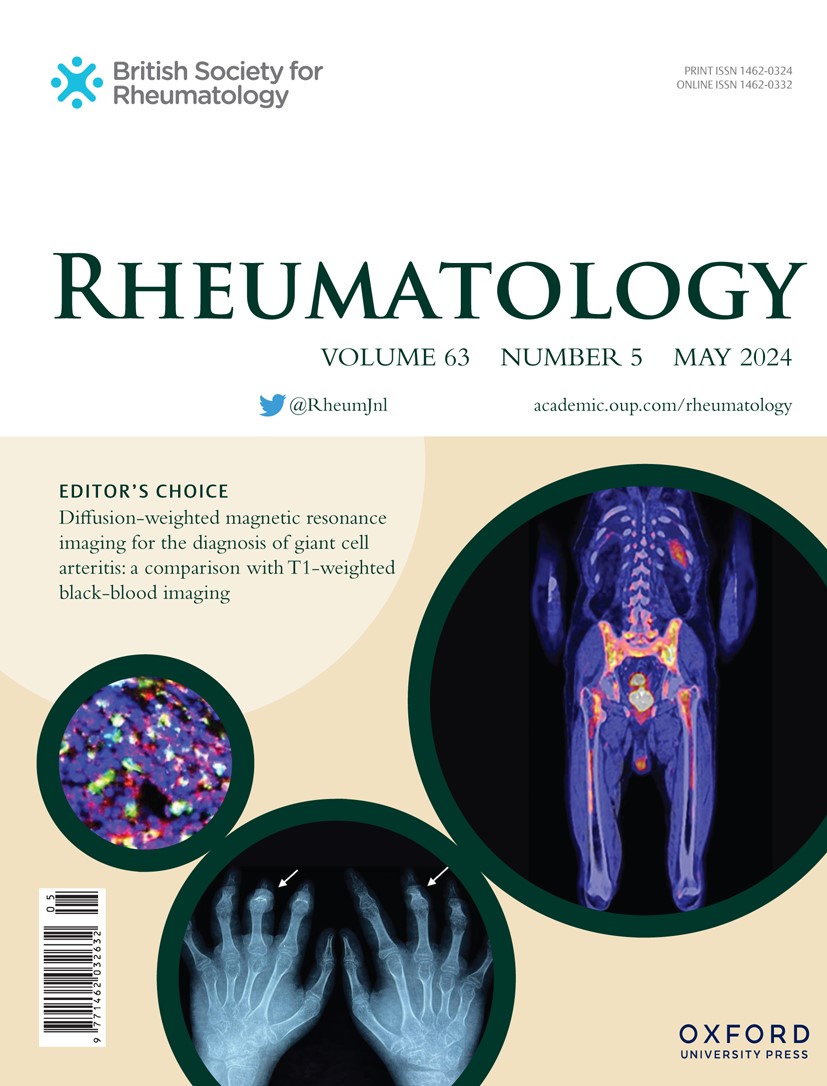早期关节炎中年龄相关b细胞的高频率与动脉粥样硬化和免疫回路有关,这是风险分层的潜在生物标志物
IF 4.7
2区 医学
Q1 RHEUMATOLOGY
引用次数: 0
摘要
目的免疫失调可能在类风湿关节炎(RA)患者心血管(CV)风险过高中起作用。然而,确切的中介是未知的。年龄相关B细胞(abc)已成为多方面的促炎介质,也存在于动脉粥样硬化微环境中,但它们在自身免疫中的作用尚不明确。我们的目的是评估炎症性关节炎早期阶段的abc频率及其作为动脉粥样硬化生物标志物的潜在作用。方法采用流式细胞术对58例早期RA患者、11例疑似关节痛(CSA)患者和33例健康对照(HC)患者的血清进行定量分析。采用多普勒超声检测动脉粥样硬化发生情况。细胞因子用多重免疫分析法测定。使用高通量靶向蛋白质组学评估心脏代谢相关蛋白。结果在CD19+和PBMCs池中,RA患者的循环abc比HC患者增加(p = 0.013和p &;lt;分别为0.001)。CSA的abc中位数频率较高。abc频率与疾病特征和传统CV危险因素无关,但与csDMARD治疗6个月和12个月时的良好治疗结果负相关。abc频率与促炎细胞因子(IFNg、TNF、IL-6和IL-21)、与B细胞和t细胞反应相关的蛋白质组学特征以及与动脉粥样硬化相关的细胞通路呈正相关。校正混杂因素后,abc预测RA患者动脉粥样硬化负担。此外,与传统仪器相比,添加abc地层显著改善了风险分层。结论:较高的abc频率是关节炎病程的早期事件,与治疗结果、炎症环境和动脉粥样硬化负担有关。在自身免疫中,abc可能是体液反应和动脉粥样硬化之间缺失的一环。本文章由计算机程序翻译,如有差异,请以英文原文为准。
Higher frequencies of age-associated B-cells in early arthritis are linked to atherosclerosis and immune circuits—a potential role as a biomarker for risk stratification
Objective Immune dysregulation may play a role in cardiovascular (CV) risk excess in rheumatoid arthritis (RA). However, exact mediators are unknown. Age-associated B cells (ABCs) have emerged as multi-faceted pro-inflammatory mediators, also in the atherosclerosis microenvironment, but their role in autoimmunity is ill-defined. Our aim was to evaluate ABCs frequencies in the earliest stages of inflammatory arthritis and their potential role as biomarkers of atherosclerosis. Methods ABCs were quantified by flow cytometry in 58 early RA patients, 11 individuals with clinical-suspect arthralgia (CSA) and 33 healthy controls (HC). Atherosclerosis occurrence was measured by Doppler-ultrasound. Cytokines were measured by multiplex immunoassays. Cardiometabolic-related proteins were evaluated using high-throughput targeted proteomics. Results Circulating ABCs were increased in RA patients compared with HC within the CD19+ and PBMCs pools (p = 0.013 and p < 0.001, respectively). Higher ABCs median frequency was found in CSA. ABCs frequency was unrelated to disease features and traditional CV risk factors but negatively associated with good therapeutic outcomes upon csDMARD at 6 and 12 months. ABCs frequency was positively correlated with proinflammatory cytokines (IFNg, TNF, IL-6 and IL-21) and proteomic signatures related to B- and T-cell responses as well as cellular pathways linked to atherosclerosis. ABCs predicted atherosclerosis burden in RA patients after adjusting for confounders. Furthermore, adding ABCs strata significantly improved risk stratification over conventional instruments. Conclusions Higher frequencies of ABCs are an early event along arthritis course, linked to therapeutic outcomes, inflammatory milieu and atherosclerosis burden. ABCs may be a missing link between humoral responses and atherosclerosis in autoimmunity.
求助全文
通过发布文献求助,成功后即可免费获取论文全文。
去求助
来源期刊

Rheumatology
医学-风湿病学
CiteScore
9.40
自引率
7.30%
发文量
1091
审稿时长
2 months
期刊介绍:
Rheumatology strives to support research and discovery by publishing the highest quality original scientific papers with a focus on basic, clinical and translational research. The journal’s subject areas cover a wide range of paediatric and adult rheumatological conditions from an international perspective. It is an official journal of the British Society for Rheumatology, published by Oxford University Press.
Rheumatology publishes original articles, reviews, editorials, guidelines, concise reports, meta-analyses, original case reports, clinical vignettes, letters and matters arising from published material. The journal takes pride in serving the global rheumatology community, with a focus on high societal impact in the form of podcasts, videos and extended social media presence, and utilizing metrics such as Altmetric. Keep up to date by following the journal on Twitter @RheumJnl.
 求助内容:
求助内容: 应助结果提醒方式:
应助结果提醒方式:


